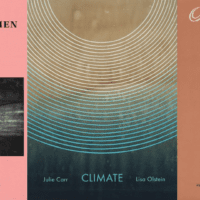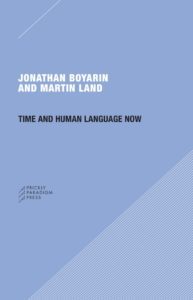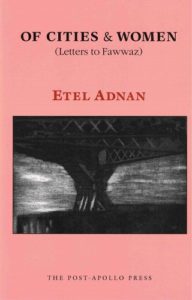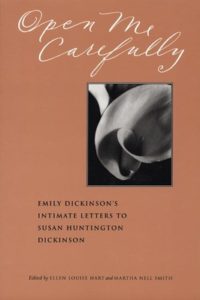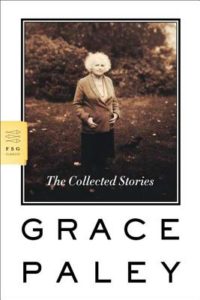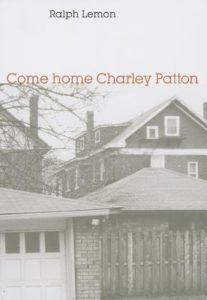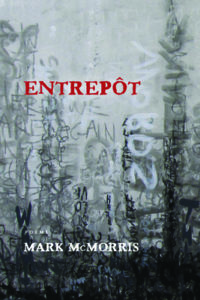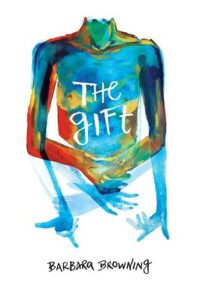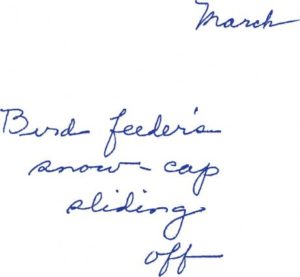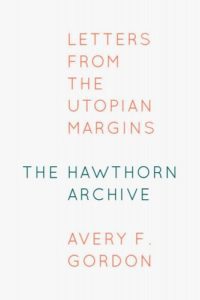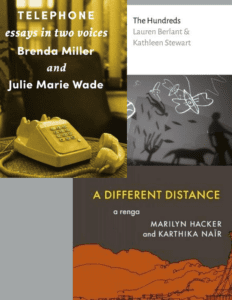The letter is a slow form. Response will come, the letter writer hopes, but only later after the addressee has time: to receive, to read, to mull it over, to write, to send. People in extended correspondence develop, in this way, a shared temporality running alongside or under the ordinary tempo of their days. In times of intense anxiety or activity, this alternate slow-time might provide a kind of bassline, something to rely on, against which to steady oneself. Or, in the excitement of shared ideas, it might offer a quickening. And of course, the letter is also an intimate form. Unlike essays, unlike most stories and poems, the letter has only one person in mind. This “holding in mind” is a kind of care, a deliberate care. Together, the letter writers construct their intimacy intentionally, like one might plan a garden or draw a map.
Throughout all of 2018 and half of 2019, we wrote to each other, sometimes once a week, sometimes much less frequently. Because we’d committed to this process (for how long, we didn’t know), everything that happened during that eighteen-month period became something to consider writing to the other about, something to filter through the intimacy of our correspondence. In a sense, this was like living a double life. Things happened, and then they happened again, between-us. There were fires, floods, national and international crises, mass shootings, #MeToo, as well as illnesses and tragic losses within our close circles. There were ordinary moments too, the daily cycles of mothering, working, dreaming, and writing. And there was reading. For as we wrote to each other, we also studied, in a sense, the epistolary form. Other letter-writers had found solace, often during unsettled times, through constructing an “I” in language that in the very act of writing to another, also anticipates becoming a “you.” Below are some of the books that inspired us to begin or kept us company while we wrote Climate, our book of epistolary essays, published by Essay Press later this month. We hope these books might do the same for you.
***
Time and Human Language Now by Jonathan Boyarin & Martin Land
Time and Human Language Now is a small book of letters that opens immediately into a vast universe of ideas. In it, two old friends—one an anthropologist, the other a physicist—pick up the thread of what seems to be a lifelong conversation, urgently questioning where we find ourselves in the pivotal present, that precarious X marked on a sweeping timeline of evolution and thought. “What do you say after you’ve said that the world is ending? The answer (one answer) is: you seize the miracle of being able to talk, now, still . . You talk about the astonishment of communication, of dialogue. You talk about how much we still have to lose.” Intimate and erudite, the exchange comprises an experiment in “epistolary scholarship.” In it we encounter a dazzling array of subjects and angles of approach: politics ricochet off physics, extinction is placed in contexts scientific and spiritual, the origin story of a Yiddish expression rubs elbows with a mini-disquisition on Julia Kristeva’s idea of hospitality which leads to a tender, incisive consideration of what it means to write a letter or to speak to another at all: to be an “I” who addresses a “you,” and how a particular kind of time is invented between the two.
Of Cities & Women (Letters to Fawwaz) by Etel Adnan
A slender gem of a book, Of Cities & Women casts off formal restriction in favor of something more expansive. Adnan promised an editor-friend an essay on feminism; instead she wrote him nine letters over two years, not so much fulfilling the brief as transforming it. “Dear Fawwaz,” she writes at the outset, “I meant to write you a letter about feminism from Barcelona, for the special issue of ‘Arab Women’ of your magazine, Zawaya. But how could I join the two projects of discovering a city (a country) and of reflecting upon such a vast subject?” Identifying the problem, she solves it by inhabiting instead the letter, genre of travelers and separated friends, literary mode flexible enough to encompass the widest range of registers. Amidst questions of feminism, art, ambition, politics, and war, Adnan—poet and painter—focuses especially on place: the way the light refracts off water here, as opposed to here, the way things such as light refracting infiltrates a mind, its inclinations and moods, its memories. Beautifully, keenly observant, and everywhere tinged with the combination of joy and sorrow the world gives us each day, the letters trace Adnan’s travel from place to place (Barcelona, Berlin, Beirut, Rome, and more) between 1990 and 1992, inevitably charting the geography and the geopolitics around her, but most hauntingly journeying into interior realms of attachment and loss.
Open Me Carefully: Emily Dickinson’s Intimate Letters to Susan Huntington Dickinson edited by Ellen Louise Hart & Martha Nell Smith
In the contemporary context of increasingly capacious Emily Dickinson scholarship and access to her archival materials—not to mention cheeky Hulu shows—it’s easy to forget just how sealed up and sealed off she was behind certain (paternalistic, sexist, homophobic) narratives constructed after her death. Nearly twenty-five years ago, when they published Open Me Carefully, editors Ellen Louise Hart and Martha Nell Smith, along with Paris Press, were undertaking a radical step in this corrective and rehabilitative work. The volume selects, and represents as accurately as possible through both typography and facsimile reproductions, a treasure trove of letters, letter-poems, and poems from Emily’s thirty-six year correspondence with the woman who was her closest friend, sister-in-law, beloved, and primary reader. Here we see Dickinson’s genius in its natural environment: grounded in epistolary energy and form, in daily life, and in relationship. The editors deftly offer intriguing context, making note, for instance, of how Dickinson used line lengths and dashes in her letters much as she did in her poems or when Dickenson sought input on a poem’s draft. At their most playful or somber, Dickinson’s poems often feel like direct transmissions, like charged notes delivered from her consciousness to her reader’s. Open Me Carefully shows how this was often literally true and that that reader was, at least on one mortal plane, specific, and her name was Sue.
They Can’t Kill Us Until They Kill Us by Hanif Abdurraqib
They Can’t Kill Us Until They Kill Us isn’t a book of letters, but of nonfiction pieces that feel like letters in the immediacy of their address, the intimacy of their tone, and the way they unfold like great conversations. Labeled essays, the book collects short prose published in a wide range of outlets including MTV News, ESPN The Magazine, and The New York Times, as well as previously unpublished work. Individually, the mostly short, episodic pieces are simultaneously intense, rangy, and recursive; they feel like missives, like arrows shot from the heart, or like the smooth stone of something—a realization, a connection, a shape only visible in retrospect—turned over in the mind and finally ready to be shared. Together, they gather and accrue in the way of a sustained correspondence. The fact that the work revolves around music—exploring individual songs, artists, and albums; certain sounds, movements, and clubs; those seasons when you lived by (and through) a certain soundtrack—helps make this magic, reflecting on and embodying the ways music, like letters, can mark moments and bend time.
The Collected Stories by Grace Paley
Grace Paley was an original in the most sacred sense of that much-diluted word. In every sentence, she sounded inimitably like herself, which is to say like no one else on the page and uncannily like any number of real people you might know. Her brilliant work is defined by voice in the literal and literary sense: Every sentence courses with a feeling of spoken-ness and reveals character in ways only patterns of speech—idiom, rhythm, syntax—can. Paley was a writer, teacher, neighbor, citizen, and activist of extraordinary gifts, but her most dazzling was to capture the cadences of language the way people really use it—not all people, of course, but certain people, including herself. In this way, her written words—whether short fiction, nonfiction, or poetry—have the force and feeling usually only conveyed in letters written by someone who is sufficiently unencumbered by pretense to capture the aliveness of their own language, and who is sufficiently sympathetic to people for attention to be a form of love. And in myriad ways, she hovers over not only this project of us trying to speak honestly to and from the real circumstances of our complex, compromised, lucky, doomed lives, of being “colleagues in the writing and mothering trades,” but over the broader work of asking and answering the question she posed best: How are we to live our lives?
Come Home Charley Patton by Ralph Lemon
I’ve been living with Ralph Lemon’s complicated, layered, and entirely original works for many years. Most well-known as a choreographer, Lemon is also an artist and writer. In Come Home Charley Patton, he draws all three realms together as he documents the process of researching materials for the third section of his astounding dance-theater work The Geography Trilogy. The book is also a work of art on its own terms: In it, we follow Lemon and his daughter Chelsea on two road trips through the American South as they create and record spontaneous dances (for audiences of few or none), visit key sites in the Civil Rights struggle, and interview elders, seeking history and presence. Throughout, Lemon interlaces diary entries, photographs, and drawings with letters and transcribed phone calls between himself and his friends, fellow dancers, and family members, letters in which he and his correspondents discuss history, identity, belonging, and art-making. The inclusion of these letters (which are often funny) reveals the intimate community that surrounds all artmaking, and the multiple forms that might constitute research.
Entrepôt by Mark McMorris
This volume of sonically rich and challenging poems includes seventeen poem-letters to “Michael.” Reading these, I’m immediately struck by the urgency of the conversation I am invited to witness. “Eloquence is heard, poetry is overheard,” said J. S. Mill in 1833, imaging the poet as a person speaking to themselves. This sense of poetry as overhearing is even more pronounced when the poet is speaking to an intimate other. The poem (the letter) is not for us, and yet we are invited into its secrets, into the folds of a relationship that enabled the writing in the first place. “The wound cannot close; language is a formal exit / is what exits from the wound it documents” “Dear Michael (2)” begins, introducing the theme of language and violence which threads through the collection. These letter-poems feel timeless in the gravitas of their concerns, in their resonant musicality, and above all, in the complexity of relation they reveal and allow.
Correspondence by Paul Celan and Nelly Sachs
The relationship between violence and language is very much alive in this crucial collection of letters between two of the 20th century’s greatest poets. Celan and Sachs, both Jewish survivors of the Holocaust, accompany each other through the continued ant-Semitism of mid-century Europe, exposing fears and despair, the joy that friendship brings, and above all their shared faith in poetry as the force that could, if not save them, at least unite them. The trauma of surviving genocide is found here in the most intimate of terms. Offering a precise window into the postwar European-Jewish crisis, the collection also unfolds a passionate friendship forged in and through the written word.
The Gift by Barbara Browning
I read this book during the month before Lisa and I started writing to each other, and in some ways you could say it was, for me, the driving force behind our correspondence. Browning’s book is a novel that seems to fall into the category of auto-fiction (its main character is a writer and dancer named Barbara Anderson), but the book is less about a story than it is about a theory: that what really matters in making art is to give it away. The main character writes songs on her ukulele, records them, and sends them as gifts to friends and sometimes to strangers. (She also sends videos of hand-dances.) This gift-giving impulse leads to a long-distance relationship with a German musician, a relationship that unfolds almost entirely over email. I was enchanted by this book because Browning’s characters are intriguing and charming. Even more, I was moved by the book’s exploration of loneliness, desire, and the urgent need to make things and to share the things we make, even, or especially, with just one other person. It didn’t so much change how I think about art as reinforce what I already knew, but am often in danger of forgetting. The book’s closing lines—“I made this for you. It was the last thing I did. It comes from the heart. Love Barbara”—recall me to the first and last reason I’ve made anything: for “you.”
Homemade Poems by Lorine Niedecker
In the middle of the Vietnam War, Niedecker created a little book of thirty poems, Homemade Poems, for her friend, the poet Cid Corman. Written on a small pad bound with cardboard and covered in wrapping paper, the poems discuss love and friendship directly, such as in “Laundromat”: “Casual, sudsy // social love // at the tubs” and an untitled poem that reads: “If only my friend / would return / and remove the leaves / from my eaves / troughs.” Thanks to the Lost and Found project at CUNY, directed by Ammiel Alcalay, it’s now available in facsimile form. There are poems for or about Ian Finlay, Louis Zukofsky, and Albert Millen, Niedecker’s husband; about important nineteenth-century radicals including Margaret Fuller, Mary Shelley, and John Ruskin; and about food, the weather, and the garden, with the war frequently within the frame. A gesture of friendship and of poetics, these letter-like poems explore the pleasures of body, tongue, and nose as counter-reality to war’s horror. It’s the work of poetry to remind us of our senses, to return us to the body with its longings, pleasures, and fears; this handmade book is not only a vehicle for these ideas, it’s also an instantiation of them. Bearing the mark of the hand, the gift becomes an emissary of the body, an instance of what Niedecker calls “Life’s dance,” in which “social love” draws us near.
The Hawthorn Archive: Letters from the Utopian Margins by Avery F. Gordon
This entirely innovative book is at once a chronicle of a collaborative project of art-making, political activism, and visionary thinking and an anthology of utopian thought within global struggles for freedom spanning at least two centuries. Gordon’s extensive research into utopian thinking brings the struggles of nineteenth-century European workers into conversation with anti-colonial thinkers from the global south, and places post-Marxist theorists like Ernst Bloch alongside the liberatory practice of marronage. Herbert Marcuse and Toni Cade Bambara share pages; the writings of prison abolitionists dovetail with those of refugees. There are many letters, and many kinds of letters throughout (the book’s first page is a letter that begins, “Dear friends,” and ends, “And remember we’re cooking soup on Saturday”), but most moving to me is an extended exchange between Gordon and the artist Céline Condorelli. In their correspondence we find an example of friendship as a form of utopia-in-the-present, not because the relationship is without struggle, but because intimacy is a vehicle for struggle. This remarkable book acts as a kind of primer for how to imagine the world anew. More than that, it offers an example of what a life lived “in the utopian margins” might look and feel like: dynamic, complicated, committed, searching, and above all collaborative.
Something in the water: other contemporary collaborations
Something about the present seems to be calling out for collaboration, or more precisely, seems to be calling on us to collaborate. As we waded into our own endeavor of keeping company and thinking-through together, on the page, we began noticing what seemed a noteworthy uptick in other correspondence-based or otherwise shared projects by contemporary women writers, whether in poetry or prose: Natalie Diaz and Ada Limon’s “Envelopes of Air,” Leila Chatti and Dorianne Laux’s The Mothers: Poems in Conversation and a Conversation; Marilyn Hacker and Karthika Nair’s A Different Distance: A Renga, Lauren Berlant and Kathleen Stewart’s The Hundreds, and Julie Marie Wade and Brenda Miller’s Telephone: Essays in Two Voices, to name a few. Each iteration is, of course, entirely unique and shaped by individual artists and by the chemistry of their coming together, plus the formal and thematic contours of what they choose to map and make. But something in the impulse—one we also felt compelled to pursue—and in the spirit of these endeavors seems shared: the sustaining rhythms of call and response, the power of mutual attention and direct address, of slowing down enough to listen, of connection as a means of searching, solace, and subversion.
